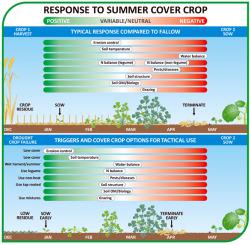Agricultural Systems ( IF 6.1 ) Pub Date : 2022-04-28 , DOI: 10.1016/j.agsy.2022.103415 Terry J. Rose 1, 2, 3 , Shahnaj Parvin 2, 3, 4 , Eusun Han 5, 6 , Jason Condon 3, 7, 8 , Bonnie M. Flohr 9 , Cassandra Schefe 8, 10 , Michael T. Rose 3, 11 , John A. Kirkegaard 6

|
CONTEXT
Cover crops are widely promoted in temperate regions of the northern hemisphere to replace or reduce fallow periods between cash crops. The reported benefits (improved ground cover, reduced nitrate leaching, increased soil organic matter among others) have prompted widespread interest in cover cropping in other agro-climatic zones, including Mediterranean environments such as southern Australia, where the wet, mild winters and hot dry summers are a stark contrast to temperate environments.
OBJECTIVE
This review considers the reported benefits of cover crops in temperate environments in the context of cropping systems in the water-limited, Mediterranean climate in the grain-growing regions of southern Australia.
METHODS
Published studies on cover cropping were critically assessed to evaluate whether the reported impacts may be relevant to Mediterranean-type climates.
RESULTS AND CONCLUSIONS
Nitrate leaching is not generally problematic in southern Australian cropping systems due to low summer rainfall and high temperatures, and complete retention of crop stubbles can adequately protect the soil from erosion. Further, summer rainfall is low and sporadic which not only limits cover crop planting opportunities but means that water conserved over summer fallows contributes significantly to winter cash crop yield. Consequently, cover crop duration would need to be short (1–2 months) to balance the benefits of increased cover for water infiltration with transpiration loss during cover crop growth. Restricted cover crop biomass production due to water constraints and short fallow length will limit the potential value of the cover crop to increase soil organic matter, microbial activity, and biologically-fixed nitrogen contributions – all reported benefits for higher biomass cover crops in temperate environments. Appropriate tactical use of summer cover crops may arise in situations where (i) soil cover is reduced by winter crop failure or prolonged drought creating significant erosion risk, (ii) recalcitrant herbicide resistant weeds in winter crops require a chemical spring fallow and summer cover/forage crop, which could be grazed, (iii) full soil profiles at harvest and wet seasonal outlook provide opportunities for cover crop growth without significant pre-emptive competition, and (iv) sandy soil profiles with low water holding capacity combined with reliable winter rainfall minimise contributions of summer rainfall to winter crop yields. The value of more diverse cover crop species to soil health in cereal-brassica or cereal-brassica-legume cash crop rotations is not known.
SIGNIFICANCE
The rationale for widespread summer cover crop use in southern Australia is currently not compelling without more evidence for the scale and mechanisms of the anticipated benefits.
中文翻译:

澳大利亚南部半干旱种植系统夏季覆盖作物的前景
语境
覆盖作物在北半球温带地区得到广泛推广,以取代或减少经济作物之间的休耕期。报告的好处(改善地面覆盖、减少硝酸盐浸出、增加土壤有机质等)已引起人们对在其他农业气候区进行覆盖种植的广泛兴趣,包括地中海环境,如澳大利亚南部,那里潮湿、温和的冬季和炎热干燥夏季与温带环境形成鲜明对比。
客观的
本综述考虑了在澳大利亚南部谷物种植区水资源有限的地中海气候种植系统背景下,覆盖作物在温带环境中的报道益处。
方法
对已发表的覆盖种植研究进行了严格评估,以评估报告的影响是否可能与地中海型气候有关。
结果和结论
由于夏季降雨量少和高温,硝酸盐浸出在澳大利亚南部的种植系统中通常不会出现问题,并且完全保留作物残茬可以充分保护土壤免受侵蚀。此外,夏季降雨量少且零星,这不仅限制了覆盖作物的种植机会,而且意味着在夏季休耕期间保存的水对冬季经济作物产量有很大贡献。因此,覆盖作物的持续时间需要很短(1-2 个月),以平衡覆盖作物生长过程中增加水渗透覆盖和蒸腾损失的好处。由于水资源限制和休耕时间短而限制了覆盖作物的生物量生产,这将限制覆盖作物在增加土壤有机质、微生物活性、和生物固定氮的贡献——据报道,在温带环境中,高生物量覆盖作物的所有好处。夏季覆盖作物的适当战术使用可能会出现在以下情况下:(i)土壤覆盖因冬季作物歉收或长期干旱造成显着侵蚀风险而减少,(ii)冬季作物中顽固的抗除草剂杂草需要化学春季休耕和夏季覆盖/可以放牧的饲料作物,(iii) 收获时的完整土壤剖面和潮湿的季节前景为覆盖作物的生长提供了机会,而没有显着的先发制人竞争,以及 (iv) 持水能力低的沙质土壤剖面与可靠的冬季降雨相结合尽量减少夏季降雨对冬季作物产量的影响。
意义
如果没有更多证据证明预期效益的规模和机制,目前在澳大利亚南部广泛使用夏季覆盖作物的理由并不令人信服。











































 京公网安备 11010802027423号
京公网安备 11010802027423号